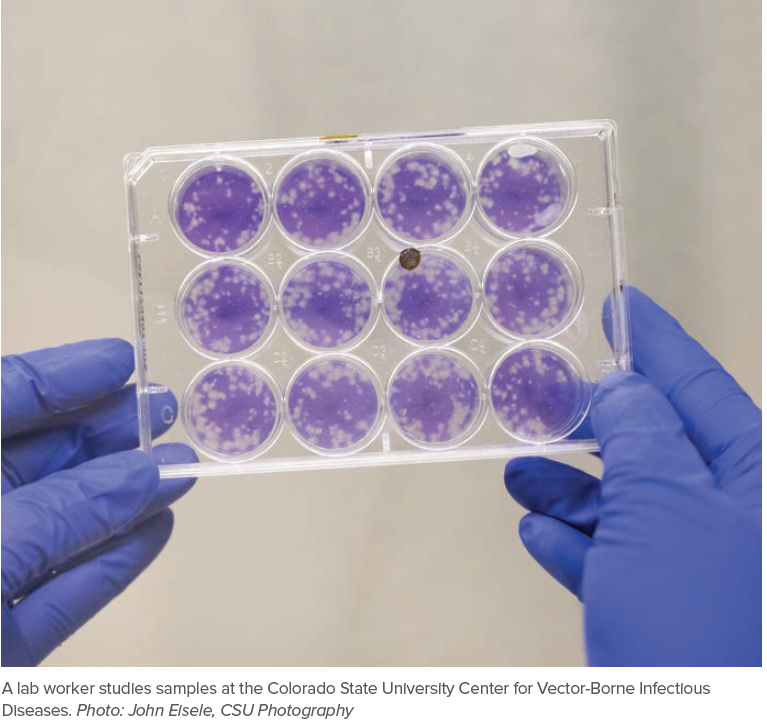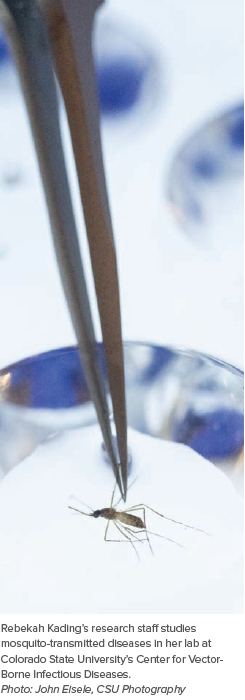Extending Reach Using a One Health Approach
By Sue VandeWoude and Claire Tucker

The CSU One Health Institute works to solve complex problems at the intersection of human, animal, and environmental health through research, training, outreach, and advocacy. By taking a transdisciplinary approach that aligns expertise across departments and colleges, the institute supports initiatives to achieve outcomes that extend individual programs’ work. Community-engaged projects highlighted here provide impact guided by local, regional, and global needs.
LOCAL IMPACT: CSU-FORT COLLINS INTEGRATED WEST NILE VIRUS MANAGEMENT
West Nile Virus is a mosquito-borne pathogen that causes disease in humans, birds, horses, and other species. First recognized in Africa, the virus was first detected in the United States in 1999. This disease emerged in Fort Collins in 2003, resulting in the death of birds of the corvid family, raptors, horses, and people. Since that time, the region has anticipated annual outbreaks. Mosquitoes are monitored for the presence of the virus, and at a particular detection threshold, the city implements insecticide spraying protocols. The city has proactively amended its control protocol over the years to minimize adverse impacts of control measures while protecting the public from this potentially fatal disease. It seeks to continuously improve its management program by relying on input from the public and scientific expertise from CSU, the Centers for Disease Control Vector- Borne Diseases Laboratory, and vector control companies.
In order to identify new detection and mitigation strategies for WNV, and to develop sophisticated approaches for the prediction and control of emergence, the institute organized more than half a dozen CSU laboratories last summer and conducted projects investigating aspects of the diseases’ ecology and transmission dynamics. With program support from the Office of the Vice President for Research and the Department of Environmental and Radiological Health Sciences, researchers focused on various aspects of WNV impacts in Fort Collins. Projects ranged from assessing genetic variants of WNV to surveillance of mosquito movements using DNA barcoded microcrystals to evaluate the historical impact of WNV and control measures on local bird and butterfly communities. A symposium was held last September to review preliminary research results and plan a coordinated approach to expand research beyond these pilot studies. Attendees from the city, county, state public health, and U.S. Centers for Disease Control and Prevention are anticipated, as well as faculty from CSU and other institutions.
The city of Fort Collins and the CDC Vector-Borne Diseases Laboratory will rely on research generated to develop applied practical outcomes to inform policy management and WNV mitigation. This will lead to a plan to detect and stop WNV outbreaks and support the community’s disease control goals. The connections fostered by this project have established partnerships that will spawn novel approaches and innovations to tackle other infectious disease outbreaks. This team will be poised to take on the grand challenge of predicting and preventing the next pandemic in the shadow of the COVID-19 pandemic.

REGIONAL IMPACT: ONE HEALTH IN 4-H IN COLORADO
One Health can be a difficult concept to convey, but it is a topic that is readily understood by youth, particularly those living in rural and agricultural areas. Recently, CSU veterinary student Bri Rosales worked with Routt County Extension Agent Libby Christenson to translate the transdisciplinary concept of One Health into an accessible and engaging curriculum for 4-H youth. The student intern rooted her work in the community, hoping to discover the unique goals and interests of 4-H youth. With the support of the CSU One Health Institute, CSU faculty from across campus involved with the institute, the CSU 4-H state office, and a field-based Extension agent advisory committee, Rosales attended county fairs, met with stakeholders, and helped 4-H students with science projects.
The resulting One Health curriculum for 4-H youth 11 to 18 years old is ready to be deployed to counties across Colorado, with hopes for expansion across the U.S. The lessons focus on zoonotic disease, vaccinations, food safety, and climate change, using various activities to improve learning. Christenson received funding from the CDC and Extension Foundation to continue this work to develop 4-H educational content that illustrates the impact and necessity of animal vaccinations to improve animal health, animal production, and public health. The goal of this work is to promote vaccine acceptance via a One Health approach. This program hopes to make the next generation of researchers, practitioners, and thinkers comfortable solving complex problems rooted in a One Health approach.
GLOBAL IMPACT: EXPANDING A ONE HEALTH SURVEILLANCE SYSTEM IN SOUTHERN GUATEMALA’S TRIFINIO REGION

LA pilot study supported by CSU OVPR in the resource-limited Trifinio region of southern Guatemala has demonstrated the feasibility of a One Health approach in disease surveillance. Greg Ebel, professor in the Department of Microbiology, Immunology, and Pathology, leads this study, which includes collaborators Dr. Valeria Scorza, a veterinarian and faculty member in the Department of Clinical Sciences, and Dr. Dan Olson, a pediatrician and investigator in the Center for Global Health at University of Colorado Anschutz Medical Campus. Mosquitoes, ticks, and fleas in the area harbor zoonotic pathogens, such as arboviruses, including Zika and dengue viruses, as well as bacterial infections, including Bartonella spp., Anaplasma spp., and Ehrlichia spp., among others. The interdisciplinary team of researchers joined partners from Universidad del Valle de Guatemala and the local Trifinio site to study the prevalence and spread of these diseases.
Blood samples, ticks, and fleas were collected from humans and animals (dogs, cats, pigs, turkeys, chickens, ducks), examining the presence of diseases across each species. Blood-fed mosquitos were collected from households to assess pathogens circulating in the blood of animals and people. Local partners were trained to lead sample acquisition in various domestic animals living in the region, developing critical relationships to support research into the future.
The preliminary data has revealed pathogen burden in animals and their fleas and ticks, and has extended our pioneering use of mosquito sampling to assess the burden of disease in the region. The sampling of humans and animals in the same study has proved invaluable to show linkages in disease transmission. Future work includes testing for additional agents such as SARS-CoV-2 and influenza viruses, expanding the program to include soil, manure, and watershed samples, and building local capacity around disease detection, prevention, and treatment. The group has recently been awarded funds from the National Institutes of Health, with the long-term goal of developing community-based interventions to reduce the burden of zoonotic disease.
THE WORK AHEAD
The One Health Institute and the Office of the Vice President for Research are committed to the future of research that transcends single disciplinary boundaries to serve specific community needs. The project outlined here illustrates the importance of developing partnerships with many stakeholders to achieve relevant, translatable, and tangible outcomes.